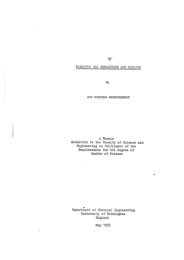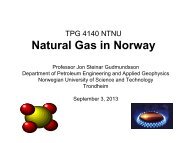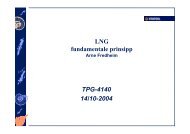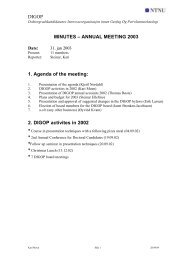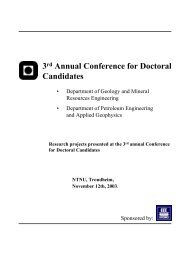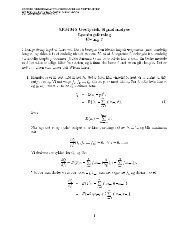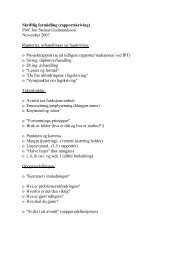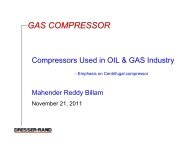Slug Catchers in Natural Gas Production - NTNU
Slug Catchers in Natural Gas Production - NTNU
Slug Catchers in Natural Gas Production - NTNU
Create successful ePaper yourself
Turn your PDF publications into a flip-book with our unique Google optimized e-Paper software.
Karam – <strong>Slug</strong> <strong>Catchers</strong> <strong>in</strong> <strong>Natural</strong> <strong>Gas</strong> <strong>Production</strong><br />
form of bubbles or droplets <strong>in</strong> the cont<strong>in</strong>uous liquid phase. Annular (wavy) flow (A-AW) arises when<br />
the flow rate is the highest. Hence, the liquid will form an annular film around the tube; but the film is<br />
thicker at the bottom than at the top of the tube. Some small amplitude waves disrupt the <strong>in</strong>terface<br />
between the liquid film and the gas; as well, some droplets may be found <strong>in</strong> the gaseous phase<br />
(Walveribne Tube Inc, 2007, Azzopardi, 2010 and Bratland, 2010).<br />
Counter-current flow represents one of the aspects encountered <strong>in</strong> multiphase flow. Counter-current<br />
takes place normally as the flow is flow<strong>in</strong>g <strong>in</strong> an upward direction. Hence, gravity plays a major role;<br />
it pulls the heavier phase of the gas-liquid mixture downwards. Each layer drags the other one<br />
oppositely to its flow direction. In such a flow type, double holdups are always expected. The bubble<br />
<strong>in</strong>stability leads to a difficulty <strong>in</strong> the prediction of the flow’s velocity. Counter-current flow limitation<br />
takes place when the gas flow rate <strong>in</strong>creases. This <strong>in</strong>crease causes a decrease <strong>in</strong> the delivered liquid<br />
flow rate.<br />
Liquid fallback can be <strong>in</strong>hibited by a pressure difference applied on the fluids and an <strong>in</strong>terfacial shear<br />
between the two phases present <strong>in</strong> the pipe. In order to <strong>in</strong>hibit this occurrence, the <strong>in</strong>terfacial shear<br />
should be high. This is ma<strong>in</strong>ly implemented with an <strong>in</strong>crease <strong>in</strong> the gas flow rate which should be able<br />
to lift the liquid exist<strong>in</strong>g <strong>in</strong> the form of either a film or droplets. Furthermore, the pressure differential<br />
should be high as well <strong>in</strong> order to overcome the liquid-wall stress and the gravity that pull the liquid <strong>in</strong><br />
the other direction. To simplify, the direction of the liquid-wall shear determ<strong>in</strong>es whether the flow is a<br />
co-current or counter-current flow. A positive shear corresponds to a co-current flow while a negative<br />
shear corresponds to a counter-current flow.<br />
2.2 <strong>Slug</strong> Flow<br />
<strong>Slug</strong>, which is a lump of liquid, has been one of the major concerns of the <strong>in</strong>dustry when it comes to<br />
transport of flow <strong>in</strong> multiphase flowl<strong>in</strong>es. The slug normally forms as a result of retrograde<br />
condensation when the reservoir pressure drops below the dew po<strong>in</strong>t. The presence of a slug flow <strong>in</strong><br />
the flowl<strong>in</strong>es leads to an unsteady hydrodynamic behavior. The latter is the consequence of an<br />
alternat<strong>in</strong>g flow of liquid slugs and gas pockets. The liquid level <strong>in</strong> the <strong>in</strong>let separator will be affected;<br />
a good separation is <strong>in</strong>hibited and <strong>in</strong> the worst case scenario, a flood<strong>in</strong>g of the separator will occur.<br />
Page 4 of 56



